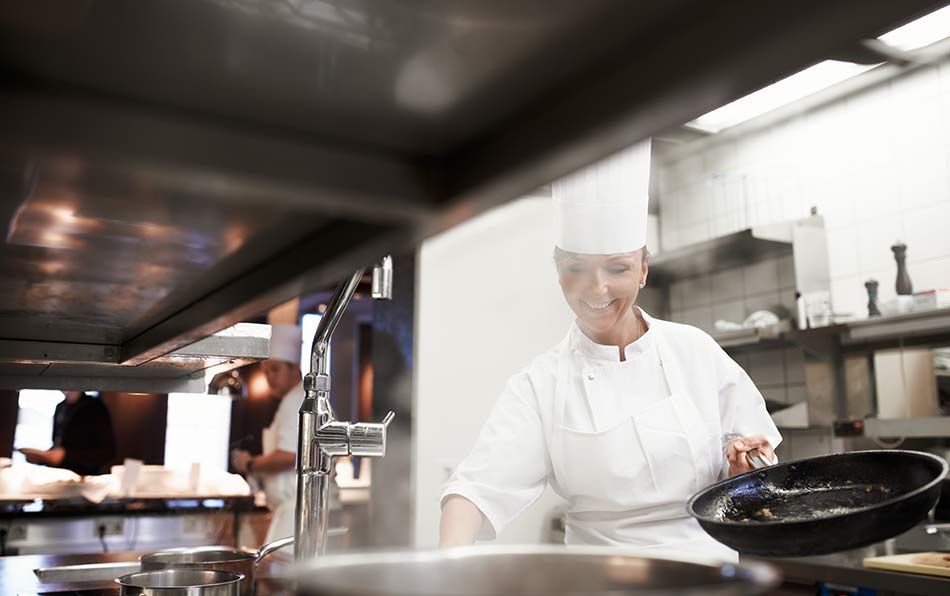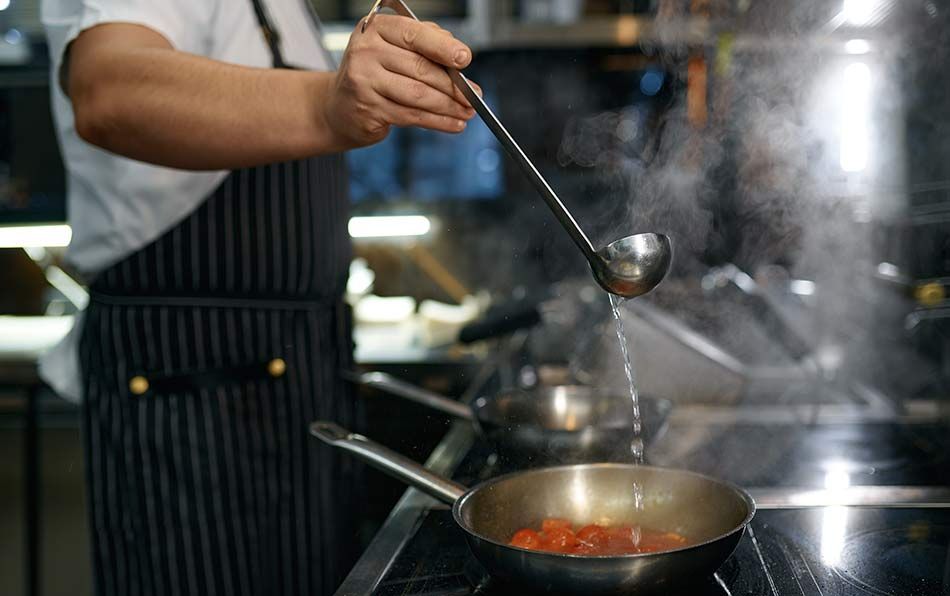Smaller restaurants typically have just one Chef, but in bigger restaurants, there are multiple Chefs and Cooks. In these two different environments, Chefs have different roles and responsibilities.
The two key positions you'll find in most large kitchens are the Head Chef and the Sous Chef. While they do similar work, these positions differ in their key responsibilities and have different ranks in the kitchen hierarchy.
To help you make the Head Chef vs. Sous Chef distinction, let's define both roles and compare them.
Definitions and Key Differences of a Head Chef vs. Sous Chef
A chain of command exists in every kitchen, and both the Head Chef and the Sous Chef play key roles in it. However, the two roles are not the same and they don't have the same duties and responsibilities. Let's clear up the distinction by defining both roles.
What is a Head Chef?
A Head Chef is responsible for all kitchen operations. They make all the major decisions related to the kitchen and are in charge of menu planning, staffing and inventory management.
It's up to them to ensure the entire kitchen performs at the highest standards. In addition, they're responsible for budgets and making sure the kitchen isn't a financial disaster.
As the leader in the kitchen, the Head Chef has to create a positive work environment for the whole team.
Besides the role of the Head Chef, large restaurants also have the Executive Chef role. They sit higher in the hierarchy and make all of the big-picture decisions.
What is a Sous Chef?
A Sous Chef is second-in-command in the kitchen and works directly under the Head Chef. They assist them in various tasks and manage the kitchen in their absence.
The role of a Sous Chef also involves being familiar with all aspects of kitchen operations and being ready to step in and perform any task when necessary.
The Sous Chef plays an important role in training and mentoring new kitchen staff members.
Smaller kitchens don't always have a Sous Chef, while large ones can have more than one. In such cases, there are slight variations to the title to further specify their place in the kitchen hierarchy. Most commonly, these are junior and senior Sous Chef titles. The term "Sous Chef" comes from the French "Sous-Chef de Cuisine", which translates to "UnderChef of the kitchen".
Roles and Responsibilities of a Head Chef vs. Sous Chef
Both the Head Chef and Sous Chef oversee the rest of the kitchen staff and play important roles in food preparation. While these two roles share some responsibilities, they have different workloads. Here are some key differences.
Key responsibilities of a Head Chef
Every restaurant menu should stand out and be the attraction that brings customers back. The job of the Head Chef is to come up with dishes that match the restaurant's theme. This includes both traditional meals customers will be familiar with, as well as their own unique creations.
Of course, working in a kitchen environment means they have an entire team to help them do this. While they focus on creating new recipes, other kitchen staff members help them deliver top-quality dishes to the customers. However, before the dishes are served, the Head Chef typically tastes them and checks whether plating has been done correctly.
Another thing the Head Chef does is keep track of inventory to ensure the kitchen is fully stocked at all times. In addition, they keep track of kitchen expenses to ensure it operates within budget.
In any restaurant, hygiene is extremely important. While overseeing the rest of the kitchen team, the Head Chef has to make sure everyone is complying with health and safety regulations.

Key responsibilities of a Sous Chef
The Sous Chef does similar work to the Head Chef. However, they work more closely with the rest of the team and have slightly fewer responsibilities.
Their main duty is to assist the Head Chef in all kitchen activities. Whether it's menu creation or staff supervision, the Sous Chef performs tasks they're given by the Head Chef. Additionally, they run the kitchen in the Head Chef's absence.
The Sous Chef is also in charge of training new kitchen workers and helping them settle in. Additionally, they look for opportunities to provide further training to current staff members and help them improve in their roles.

In addition to overseeing daily kitchen operations, Sous Chefs play a pivotal role in quality control, ensuring that each dish meets the restaurant's standards before it reaches the customer. They also handle inventory management, keeping track of supplies and placing orders to prevent shortages or overstocking. Furthermore, Sous Chefs often lead training sessions for junior staff, fostering skill development and maintaining a cohesive team environment.
Key Skills Required for Each Role
It takes a lot of skill to move up the ranks and become a Chef. Those who perform the best and help the restaurant build its reputation can advance to the roles of Sous Chef and Head Chef. Let's examine some key skills needed to work in each respective role.
Skills a Head Chef should have
The Head Chef is the "boss" of the kitchen. They're often viewed as a visionary who not only prepares exceptional dishes, but also creates new recipes.
Since they're managing the entire kitchen team, they should also be able to create a positive working atmosphere for everyone. This includes keeping the morale up and giving advice and passing knowledge onto other team members.
In popular restaurants that have a lot of customers, delivering dishes on time can be challenging, especially during peak hours. The Head Chef has to keep the kitchen running efficiently even when things get hectic.
Kitchens often have set budgets they need to operate within. It's up to the Head Chef to make any big financial decisions that impact kitchen operations.
Additional Skills for Head Chefs
- Financial Acumen: Head Chefs must manage budgets, control food costs, and maximize the establishment’s revenue. This includes making informed decisions about menu pricing and ingredient sourcing.
- Menu Development: Creating and planning menus that align with the restaurant's concept and appeal to customers is a critical responsibility. This involves developing new recipes and updating existing ones to maintain customer satisfaction.
Skills a Sous Chef should have
As the second in command in the kitchen, the Sous Chef should be good at managing the rest of the team but also at delivering excellent meals.
Amazing cooking skills are essential for all Chefs, and the Sous Chef role is no exception. They should be able to assist the Head Chef in creating traditional dishes and inventing new recipes.
Additionally, they should be familiar with all kitchen positions and jump into those roles when necessary. They have to be able to perform well, no matter the task they've been given.
In the Head Chef's absence, the Sous Chef should be able to run the kitchen just as well as the Head Chef and deliver quality dishes to customers as usual.
Additional Skills for Sous Chefs
- Versatility: Sous Chefs should be familiar with all kitchen positions and be prepared to step into any role as needed, ensuring smooth kitchen operations.
- Training and Mentorship: They are responsible for training new kitchen workers, helping them settle in, and providing ongoing development opportunities for current staff members.
Educational Requirements and Career Pathways
Aspiring Head Chefs and Sous Chefs often pursue formal culinary education to build a strong foundation in cooking techniques and kitchen management. Many enroll in culinary arts programs offered by accredited institutions, which provide comprehensive training in various cuisines, food safety, and kitchen operations.
Additionally, obtaining certifications such as the Certified Sous Chef (CSC) or Certified Executive Chef (CEC) from recognized culinary organizations can enhance professional credibility and open doors to advanced career opportunities. Continuous learning through workshops, seminars, and mentorship under experienced chefs further refines skills and keeps culinary professionals abreast of industry trends.
Career Pathways
- Head Chef: The journey to becoming a Head Chef usually involves years of experience in various kitchen roles, including line cook, station chef (Chef de Partie), and Sous Chef. Demonstrating exceptional culinary skills, leadership, and the ability to innovate are key factors in ascending to the Head Chef position.
- Sous Chef: Aspiring Sous Chefs often begin in entry-level kitchen positions, gaining experience and honing their skills. Progression typically involves moving up to station chef roles before being promoted to Sous Chef. Strong organizational abilities and proficiency in various cooking techniques are essential for this role.
Work Environment and Typical Hours
The day-to-day experience for Head Chefs and Sous Chefs can differ significantly depending on the type of establishment they work in.
- Head Chef: Head Chefs spend much of their time planning, overseeing kitchen operations, and managing staff. In fine-dining restaurants, they may work long hours, often late into the evening. They are also responsible for coordinating with suppliers and attending management meetings.
- Sous Chef: Sous Chefs are often more hands-on in the kitchen, actively preparing dishes alongside line cooks. Their hours can be demanding, including weekends and holidays. Since they are second-in-command, they are required to step in if the Head Chef is unavailable.
Also, the roles of Head Chef and Sous Chef demand long hours in a high-pressure environment, often including evenings, weekends, and holidays. Head Chefs bear the responsibility of menu development, budgeting, and maintaining relationships with suppliers, which may require administrative work outside of regular kitchen hours.
Sous Chefs, while primarily focused on hands-on kitchen management, must be adaptable, stepping into various roles as needed to ensure service runs smoothly. Both positions require physical stamina, excellent time management and the ability to make quick decisions under pressure.
Leadership and Communication Styles
Effective leadership and communication are vital for smooth kitchen operations. While both Head Chefs and Sous Chefs lead teams, their approaches often differ:
- Head Chef: Head Chefs typically adopt a top-down leadership approach, delegating tasks and setting the overall vision. Their communication style tends to be directive, ensuring every team member clearly understands their responsibilities.
- Sous Chef: Sous Chefs act as intermediaries between the Head Chef and the kitchen staff. They rely heavily on collaborative communication, frequently providing feedback and ensuring the kitchen team feels supported. This role often requires conflict resolution skills to address any issues that arise during service.
Beyond leadership and communication, both Head Chefs and Sous Chefs must possess exceptional organizational skills to manage multiple tasks simultaneously, from coordinating food preparation to scheduling staff shifts. Culinary creativity is crucial for menu innovation and adapting to dietary trends.
A deep understanding of food safety regulations and the ability to enforce these standards ensures a hygienic kitchen environment. Financial acumen, including budgeting and cost control, is also important, particularly for Head Chefs who oversee the kitchen's financial performance.
Head Chef vs. Sous Chef: Final Thoughts
Large restaurants and other establishments in the hospitality industry, such as hotels and cruises, often employ a Head Chef and a Sous Chef.
Even though both roles share tasks and duties, they're different enough to warrant having separate titles. Both are viewed as high-level roles and it takes a lot of experience working in a kitchen environment to reach the level of expertise required to become a Chef.











Loading comments...